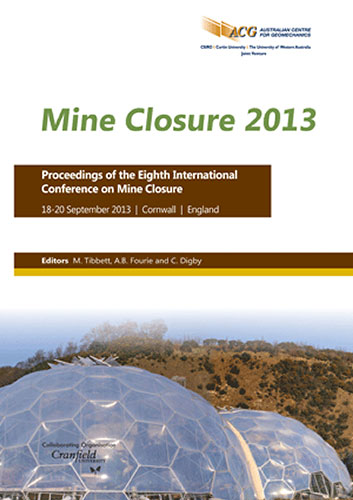Managing organisational risk for mine closure

|
Authors: Mercer, KG; Biggs, B Paper is not available for download Contact Us |
DOI https://doi.org/10.36487/ACG_rep/1352_44_Mercer
Cite As:
Mercer, KG & Biggs, B 2013, 'Managing organisational risk for mine closure', in M Tibbett, AB Fourie & C Digby (eds), Mine Closure 2013: Proceedings of the Eighth International Seminar on Mine Closure, Australian Centre for Geomechanics, Cornwall, pp. 523-535, https://doi.org/10.36487/ACG_rep/1352_44_Mercer
Abstract:
A critical issue in managing mining organisational risk is adapting to constant change that includes transfer of ownership of the mine, abandonment and mine closure as well as temporary cessation of mining activities referred to as periods of care and maintenance. During periods such as these, landforms that have been created during mining operations are likely to continue to pose significant safety and environmental risks to all stakeholders, and it can be argued that these risks may reach their greatest extent during these times. Despite ongoing rehabilitation efforts, the primary risks are likely to take the form of contaminated land, stability and erosion of the landforms such as tailings dams and waste dumps as well as management of ongoing surface and ground water contamination. After active mining has ended, these risks are likely to persist for a considerable period of time and therefore need to be continuously managed by current or future stakeholders. For final closure, the designs of the well-organised layers of protection and defences that were established during active mining operations need to be changed and adapted to meet the passive needs of managing the mine site landforms until stability and contamination risks have abated to acceptable levels and ecosystems have reached a self-sustaining state. The key issues are to adapt layers of protection and defences to accommodate:
References:
Reason, J. (1997) Managing the Risks of Organisational Accidents, Ashgate, 272 p.
Reason, J. (2008) The Human Contribution, Unsafe Acts, Accidents and Heroic Recoveries, Ashgate, 310 p.
Robbins, S.P., Judge, T.A., Millett, B. and Waters-Marsh, T. (2008) Organisational Behaviour, 5th Edition, Frenchs Forest, Pearson Education Australia, Sydney.
Tongway, D. J. and Ludwig, J. A. (2009) In “The Princeton Guide to Ecology”, Ed Simon Levin, Princeton University Press, 2009, ISBN978-0-691-12839-9.
Vick, S. (2001) Stability aspects of long-term closure for sulfide tailings, in Proceedings Seminar on Safe Tailings Dam Constructions, 20–21 September 2001, Gällivare, Sweden.
© Copyright 2026, Australian Centre for Geomechanics (ACG), The University of Western Australia. All rights reserved.
View copyright/legal information
Please direct any queries or error reports to repository-acg@uwa.edu.au
View copyright/legal information
Please direct any queries or error reports to repository-acg@uwa.edu.au